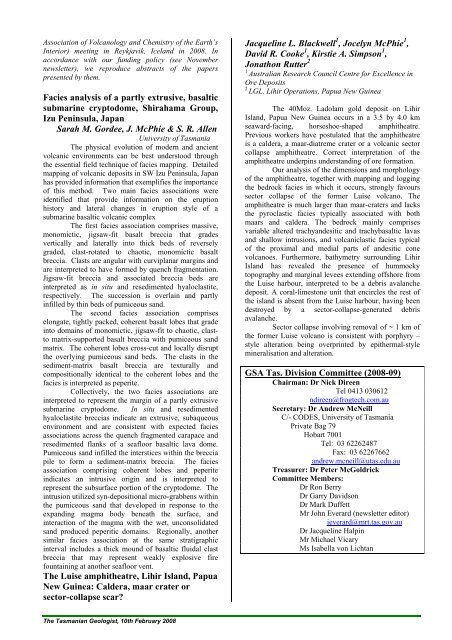The Tasmanian Geologist - Geological Society of Australia
The Tasmanian Geologist - Geological Society of Australia
The Tasmanian Geologist - Geological Society of Australia
Create successful ePaper yourself
Turn your PDF publications into a flip-book with our unique Google optimized e-Paper software.
Association <strong>of</strong> Volcanology and Chemistry <strong>of</strong> the Earth’s<br />
Interior) meeting in Reykjavik, Iceland in 2008. In<br />
accordance with our funding policy (see November<br />
newsletter), we reproduce abstracts <strong>of</strong> the papers<br />
presented by them.<br />
Facies analysis <strong>of</strong> a partly extrusive, basaltic<br />
submarine cryptodome, Shirahama Group,<br />
Izu Peninsula, Japan<br />
Sarah M. Gordee, J. McPhie & S. R. Allen<br />
University <strong>of</strong> Tasmania<br />
<strong>The</strong> physical evolution <strong>of</strong> modern and ancient<br />
volcanic environments can be best understood through<br />
the essential field technique <strong>of</strong> facies mapping. Detailed<br />
mapping <strong>of</strong> volcanic deposits in SW Izu Peninsula, Japan<br />
has provided information that exemplifies the importance<br />
<strong>of</strong> this method. Two main facies associations were<br />
identified that provide information on the eruption<br />
history and lateral changes in eruption style <strong>of</strong> a<br />
submarine basaltic volcanic complex<br />
<strong>The</strong> first facies association comprises massive,<br />
monomictic, jigsaw-fit basalt breccia that grades<br />
vertically and laterally into thick beds <strong>of</strong> reversely<br />
graded, clast-rotated to chaotic, monomictic basalt<br />
breccia. Clasts are angular with curviplanar margins and<br />
are interpreted to have formed by quench fragmentation.<br />
Jigsaw-fit breccia and associated breccia beds are<br />
interpreted as in situ and resedimented hyaloclastite,<br />
respectively. <strong>The</strong> succession is overlain and partly<br />
infilled by thin beds <strong>of</strong> pumiceous sand.<br />
<strong>The</strong> second facies association comprises<br />
elongate, tightly packed, coherent basalt lobes that grade<br />
into domains <strong>of</strong> monomictic, jigsaw-fit to chaotic, clastto<br />
matrix-supported basalt breccia with pumiceous sand<br />
matrix. <strong>The</strong> coherent lobes cross-cut and locally disrupt<br />
the overlying pumiceous sand beds. <strong>The</strong> clasts in the<br />
sediment-matrix basalt breccia are texturally and<br />
compositionally identical to the coherent lobes and the<br />
facies is interpreted as peperite.<br />
Collectively, the two facies associations are<br />
interpreted to represent the margin <strong>of</strong> a partly extrusive<br />
submarine cryptodome. In situ and resedimented<br />
hyaloclastite breccias indicate an extrusive, subaqueous<br />
environment and are consistent with expected facies<br />
associations across the quench fragmented carapace and<br />
resedimented flanks <strong>of</strong> a seafloor basaltic lava dome.<br />
Pumiceous sand infilled the interstices within the breccia<br />
pile to form a sediment-matrix breccia. <strong>The</strong> facies<br />
association comprising coherent lobes and peperite<br />
indicates an intrusive origin and is interpreted to<br />
represent the subsurface portion <strong>of</strong> the cryptodome. <strong>The</strong><br />
intrusion utilized syn-depositional micro-grabbens within<br />
the pumiceous sand that developed in response to the<br />
expanding magma body beneath the surface, and<br />
interaction <strong>of</strong> the magma with the wet, unconsolidated<br />
sand produced peperitic domains. Regionally, another<br />
similar facies association at the same stratigraphic<br />
interval includes a thick mound <strong>of</strong> basaltic fluidal clast<br />
breccia that may represent weakly explosive fire<br />
fountaining at another seafloor vent.<br />
<strong>The</strong> Luise amphitheatre, Lihir Island, Papua<br />
New Guinea: Caldera, maar crater or<br />
sector-collapse scar?<br />
Jacqueline L. Blackwell 1 , Jocelyn McPhie 1 ,<br />
David R. Cooke 1 , Kirstie A. Simpson 1 ,<br />
Jonathon Rutter 2<br />
1<br />
<strong>Australia</strong>n Research Council Centre for Excellence in<br />
Ore Deposits<br />
2<br />
LGL, Lihir Operations, Papua New Guinea<br />
<strong>The</strong> 40Moz. Ladolam gold deposit on Lihir<br />
Island, Papua New Guinea occurs in a 3.5 by 4.0 km<br />
seaward-facing, horseshoe-shaped amphitheatre.<br />
Previous workers have postulated that the amphitheatre<br />
is a caldera, a maar-diatreme crater or a volcanic sector<br />
collapse amphitheatre. Correct interpretation <strong>of</strong> the<br />
amphitheatre underpins understanding <strong>of</strong> ore formation.<br />
Our analysis <strong>of</strong> the dimensions and morphology<br />
<strong>of</strong> the amphitheatre, together with mapping and logging<br />
the bedrock facies in which it occurs, strongly favours<br />
sector collapse <strong>of</strong> the former Luise volcano. <strong>The</strong><br />
amphitheatre is much larger than maar-craters and lacks<br />
the pyroclastic facies typically associated with both<br />
maars and caldera. <strong>The</strong> bedrock mainly comprises<br />
variable altered trachyandesitic and trachybasaltic lavas<br />
and shallow intrusions, and volcaniclastic facies typical<br />
<strong>of</strong> the proximal and medial parts <strong>of</strong> andesitic cone<br />
volcanoes. Furthermore, bathymetry surrounding Lihir<br />
Island has revealed the presence <strong>of</strong> hummocky<br />
topography and marginal levees extending <strong>of</strong>fshore from<br />
the Luise harbour, interpreted to be a debris avalanche<br />
deposit. A coral-limestone unit that encircles the rest <strong>of</strong><br />
the island is absent from the Luise harbour, having been<br />
destroyed by a sector-collapse-generated debris<br />
avalanche.<br />
Sector collapse involving removal <strong>of</strong> ~ 1 km <strong>of</strong><br />
the former Luise volcano is consistent with porphyry –<br />
style alteration being overprinted by epithermal-style<br />
mineralisation and alteration.<br />
GSA Tas. Division Committee (2008-09)<br />
Chairman: Dr Nick Direen<br />
Tel 0413 030612<br />
ndireen@frogtech.com.au<br />
Secretary: Dr Andrew McNeill<br />
C/- CODES, University <strong>of</strong> Tasmania<br />
Private Bag 79<br />
Hobart 7001<br />
Tel: 03 62262487<br />
Fax: 03 62267662<br />
andrew.mcneill@utas.edu.au<br />
Treasurer: Dr Peter McGoldrick<br />
Committee Members:<br />
Dr Ron Berry<br />
Dr Garry Davidson<br />
Dr Mark Duffett<br />
Mr John Everard (newsletter editor)<br />
jeverard@mrt.tas.gov.au<br />
Dr Jacqueline Halpin<br />
Mr Michael Vicary<br />
Ms Isabella von Lichtan<br />
<strong>The</strong> <strong>Tasmanian</strong> <strong>Geologist</strong>, 10th February 2008
















